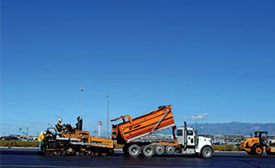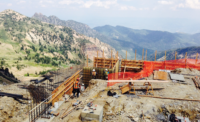Travis Farr, project manager for Wadsworth Brothers and Utah County Constructors, has worked with Staker Parson in various capacities for the past 15 years. “They have a lot of resources they can bring to a project, and they have been a very good partner,” he says. “We complement each other well. They are reliable, and when we need something done, there’s not an argument—we just get it done.”
Farr says Staker Parson is providing the aggregate and performing utility and earthmoving work, while Wadsworth is focused on paving and structures. Providing aggregate is easily done, since Staker Parson has existing pits and batch plants at either end of The Point.
In addition to The Point, Staker Parson has been working on replacement of the main terminal at Salt Lake City International Airport. The TRP project will soon seek bids for its next package, to be released in the coming months.
Downturn Strategy
Having a wide scope of services helped Staker Parson weather the economic downturn that hit the U.S. in 2008. The company was a key player in several major projects that buoyed the Utah construction market during those lean years.
Staker Parson was a major subcontractor to the joint-venture team of Big-D Construction, Balfour Beatty and DPR on the National Security Agency’s $1.2-billion Utah Data Center in Bluffdale. The company was also a supplier and subcontractor on the $1.5-billion City Creek shopping center in downtown Salt Lake City and the asphalt-paving contractor for the $1-billion UDOT I-CORE project on I-15 in Utah County.
“We were also involved in a lot of institutional work the state launched at that time, such as the Museum of Natural History and other projects at the University of Utah and other campuses,” says Parson.
During the downturn, the company took the opportunity to streamline its operations and look for efficiencies. “We created a centralized billing operation for all our accounts payable and invoices. Those operations used to be dispersed at our different locations,” Parson says. “We also doubled down on how we use technology like GPS, job modeling—anything that would make us more efficient and get a higher quality at lower cost. There was a lot of motivation to think outside of the box and see what we could do to get the most out of our existing operations.”
‘Rocks Build Our World’
“As a family business, I think we’ve been able to retain a lot of those qualities that were important to my grandpa: great customer service, commitment to people, and commitment to the construction industry and the communities we work in,” says Parson.
Part of the company’s support of the wider community comes by way of donations to local charities and an outreach program, called “Rocks Build Our World,” developed by educators and company leaders. The program targets elementary-school students and meshes with the fourth-grade geology science unit; further, the program includes hands-on experiences to help students understand the role of mining and mine products in everyday life.
“We reach thousands of kids in Utah, Idaho and Colorado each year. The kids and teachers love it, and we are asked back to take it to more schools each year,” says Parson.
The company showed off the softer side of its operations by donating tons of sand for volleyball courts in 2013, when the Association of Volleyball Professionals made the mostly beach-free Salt Lake City a stop on its national beach-volleyball tour.
Parson says that, several years ago, the company instituted a system for continuous improvement of its processes in which all company sites are audited annually for safety, efficiency and compliance. “We’ll always keep working on that,” he says.
He adds that another focus for the future will be on executing more design-build delivery. “UDOT is our largest client, and they are doing more projects and larger projects using design-build. We want to make sure we are there and can mobilize for those,” he says.




Post a comment to this article
Report Abusive Comment